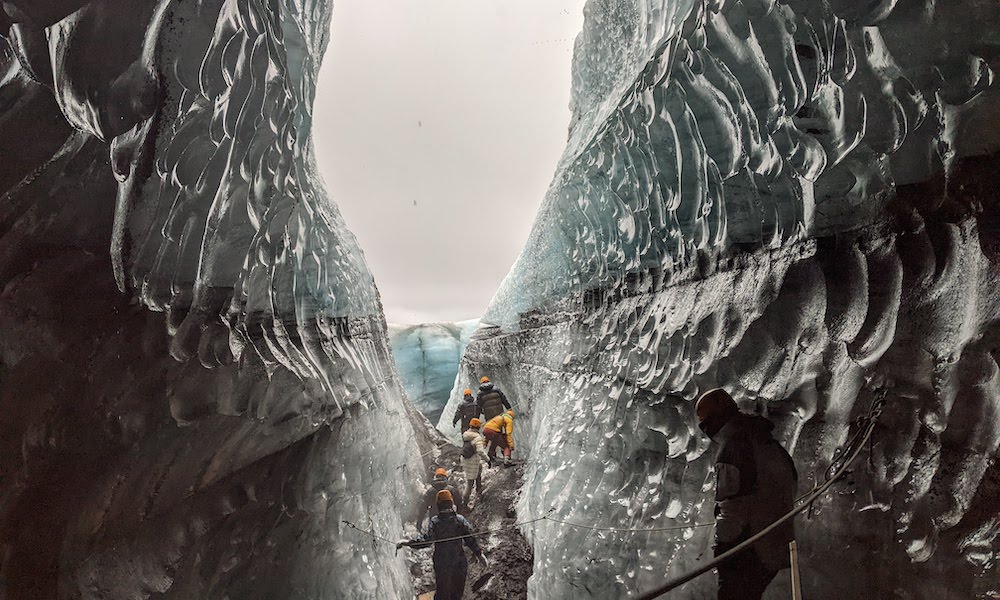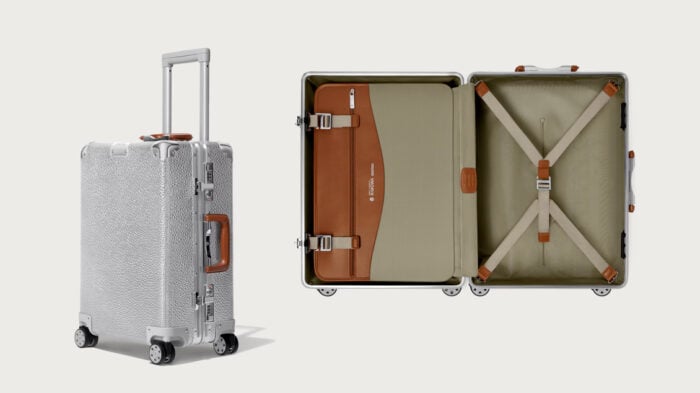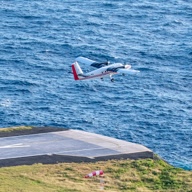My grandparents had a place in the Poconos up until I was in college, and I grew up going in and out of the Appalachians. Over time, I learned enough to be able to rattle off a few fun facts about the mountains here and there: They’re one of the oldest ranges in the world. The region was a haven for Scotch-Irish settlers in the 18th and 19th centuries after being expelled from their homelands by the English. The ice sheet covering North America was two miles thick and would certainly win the rock-paper-scissors fight that is natural terraforming. Far from being limited to North America, parts of the Appalachians from when the continents were one mass are now found in Norway, Scotland, Ireland, Iceland, and Canada.
But all of these historical points are abstract for me. I missed the Pleistocene by 17,970 years, give or take, and despite what you might say about Poconos skiing conditions, there isn’t a sheet of ice in the Appalachians anywhere close to what it once was. I lived in the landscape that glaciers created, and knowing it’s history doesn’t mean I understand what that actually means.
It took leaving the continent on a trip to Iceland to rectify that. Specifically, a visit to the Katla Ice Caves. Ours was through Arctic Adventures, one the companies that offers a more rugged take on general sightseeing.
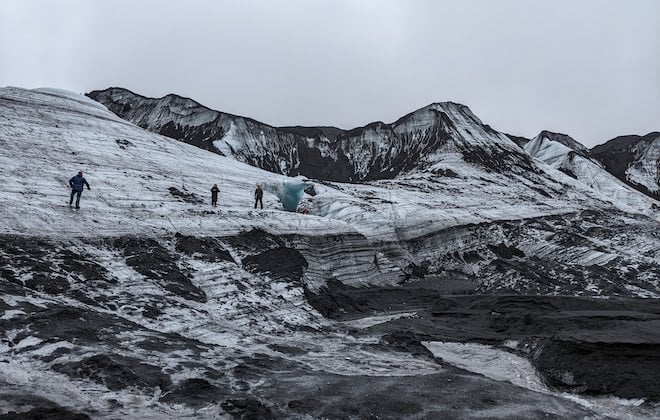
We found our tour guide, Thor, in a parking lot in Vik, a small town in south Iceland, and piled into his super Jeep with a handful of strangers. Our ride had huge tires, looked like it’d taken at least 20 years’ worth of beatings, and had a built-in air compressor to regulate the tire pressure between what’s needed for driving on pavement and crossing the black sand to the rough terrain near our hike’s starting point. The ride was like jumping on a trampoline in an exceptionally low-ceilinged sauna.
When we arrived, crampons and helmets were provided by the tour company. It’s not like I was going to refuse them, but that didn’t stop my hubristic lizard brain from scoffing. I know how to walk and not hit my head, I do it every day. Still, rationality shouted down the lizard. We put everything on and set off.
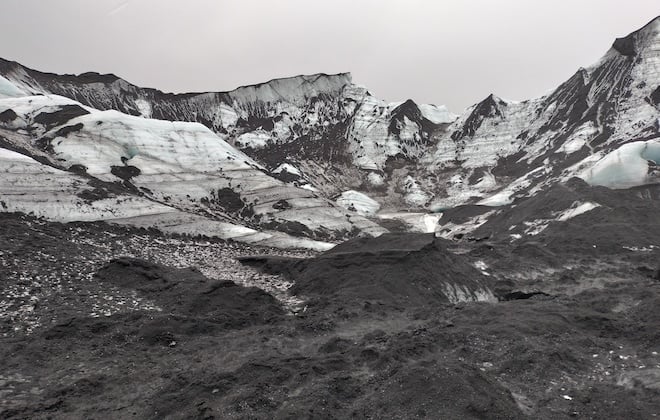
We covered about half a mile of black sand before we got to the start of the ice climb. Tiny points of white ice peeked out in the black sand, while streams of water moved at different speeds. Thor led us to a path up a shallow incline that climbed about 20 feet up and disappeared into what looked like a small hole going deeper into the glacier.
The small hole was a bit of a fakeout. It was a left hand turn through an ice arch. On the other side of the arch was a short branching path up another 20 feet to an even bigger arch while the main path continued into the cave proper. The turn was also the point of the walk where we first saw the power and volume of water melting off the glacier. It was about the width of a standard waterslide and twice as deep, a truly humbling amount of water.
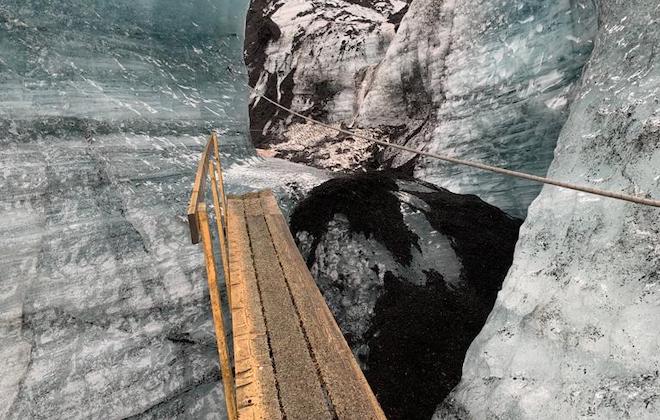
It didn’t help that the wooden bridges that crossed over the water were splintered by hundreds, if not thousands, of preceding pairs of crampons. The wood’s structural integrity looked about the same as fence posts chewed up by vicious, yippy little dogs. I took advantage of a rope for balance along the entirety of the path—I recognized my limitations, followed sensible safety precautions, and enjoyed.
On the walk, Thor gave us a good guiding philosophy: the journey in is for our eyes, and the journey out is out for our phones. He said it was a shame how many people he’d taken who saw the whole tour through their screen. Their eyes never actually see what they came on a tour to see, so they end up with great pictures but lose the impact.
There’s science behind that. It’s likely that taking too many pictures and videos offloads your memories to your phone or camera. Your brain knows that you’re taking a picture, so it doesn’t need to remember what you’re taking a picture of, despite the reason that you’re taking a picture being that you want to remember it.

I’m glad we got that advice not because I always have my face buried in my phone, but because it overrode the impulse to snap a quick picture. On the walk in, we immersed ourselves in the experience. On the walk out, we documented the parts that grabbed us. If you’re taking a picture because you’re deeply affected by something, you’re more mindful of the thing itself. The photo strengthens the memory and the memory strengthens the photo.
The stream in the middle widened out and slowed down through the majority of the cave. From there, the crossings were over less storm swollen rapids and more wide, leisurely brooks. The wood didn’t look any better, but they were crossing drops with lower stakes.
In the cave, the ice was hollowed out by all natural forces, primarily wind and water. There isn’t a jagged edge anywhere. Everything is satisfyingly smooth divots slowly sculpted by the constant movement of air and water. The black lines you see everywhere in the cave and all along the ice cliff walls were the ash and debris trapped in thin layers from the previous centuries of volcanic activity. When the ice melts, the debris falls out and gathers in sandy patches, giving the illusion of solid ground.

Eventually, the cave opens into a massive bowl, with sharp ice cliffs topping off the sides. Here, Thor gave me the dumb American’s primer on glaciers and ice caves. It was the kind of information you learn in school as a fun fact, but need to see in real life to fully understand. Glaciers aren’t static features. They’re constantly being replenished by new snowfall, which compacts, melts under the pressure, then refreezes, all the time pushing older ice away from the ice cap. In this case, we would be going through Kötlujökull glacier, an offshoot which flows out of Mýrdalsjökull glacier and covers Katla, one of Iceland’s volcanoes. It’s a flow so slow, it would take a full human lifetime to notice movement.
But that doesn’t mean the glaciers aren’t always changing. The ice caves are temporary features. The one we were in was near the end of its lifecycle, and Thor didn’t expect to get another season out of them. Over the summer, there would be so much melt that it would open the top of the cave and turn where we were into more of an ice alley than a fully enclosed cave. Traces of this were already visible: Gem-like blue ice revealed places where the ice is thin enough for natural light to get through.
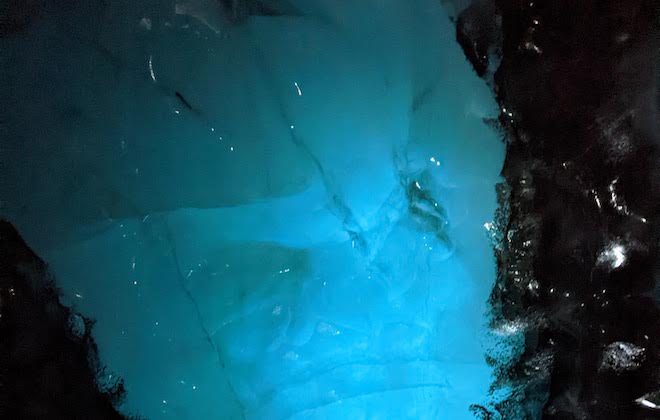
At the same time, the melt would open a new cave. Thor pointed out where the guides expect they’ll be going in future seasons based on gaps in the floor where water flowed out of the current ice cave.
Talking to him also prompted the kind of slow burning realization that stops the obvious from being taken for granted and brings the full weight of reality smashing down on you. I went from, “Of course this is all ice” to “Holy shit, this is all ice.”
Everything around you is ice. The walls and cliffs are ice. In the cave, the ceiling is ice. The floor below you for at least 20 feet, probably more, is ice. That mountain you saw coming in and thought, “huh, tall ice” was ice. It’s the same stuff you put in novelty shapes for cocktails, hardened and shaped like stone, rising from black sand, pushing itself out from a gap in a mountain range that’s holding back even more ice.
I see miles of dirt and rock every day. I’ve hiked up mountains to look out over landscapes of bare rock and all the things that grow in dirt. Tectonic plates that are miles thick float on rocks so hot they melt, then smash into other plates and push up mountain ranges. It all fits in nice and clean in my brain and causes no dissonance whatsoever.

The most ice I’ve ever encountered was when my parents would tell me to be careful driving to high school after a winter storm. We’d get some compacted snow or the day’s melt would freeze overnight. We call them ice sheets in a colloquial way befitting our regular lives.
Now, we were standing in a bowl of geological ice. It’s ice as a force of nature, not a roadway hazard. It’s ice that takes 800 years to flow down to its current spot, grinding up whatever unfortunate boulder got caught underneath. It’s ice that started moving the same time Ghengis Khan was tearing apart Asia, the Crusades were burning themselves out, and the Pueblo were carving out Mesa Verde.
Of all the things we did in Iceland, the ice cave walk did the most to fundamentally alter the way I see the world. It turned the abstract practical. I know I’ll never see the Pleistocene, but now I at least had some context for it. It’s a little easier to understand the insistence of a glacial flow when you’ve stood inside of one. You get slapped by the blinding sense of scale and awe that happens when you encounter nature on its own terms. Our round trip was probably only two miles, but for most of it, all we saw was ice. And there used to be more.
All photos provided by Dillon McLaughlin

